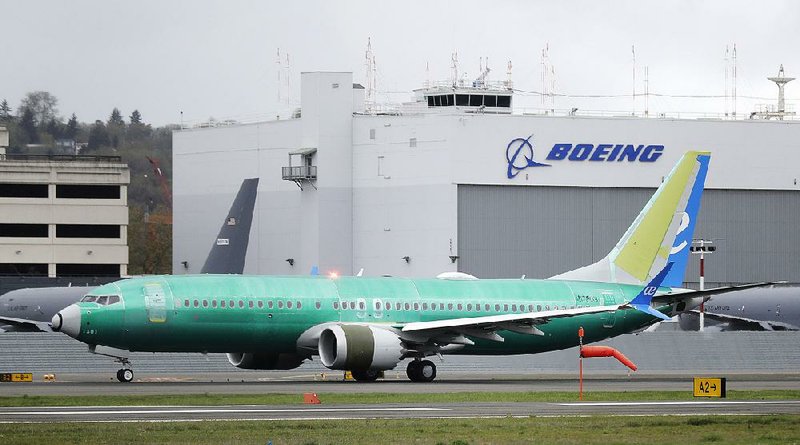In 2014, Boeing persuaded the Federal Aviation Administration to relax the safety standards for the new 737 Max related to cockpit alerts that would warn pilots if something went wrong during flight, according to documents reviewed by the Seattle Times.
Seeking an exception, Boeing relied on a special FAA rule to successfully argue that full compliance with the latest federal requirements would be "impractical" for the Max and would cost too much.
Based on lessons learned from past airline accidents, the FAA regulation stipulates precise design details for the warning displays in the cockpit. These are aimed at ensuring that alerts relay clearly to the pilots what's going on when a malfunction occurs, catch attention so that they won't be overlooked, and avert any possible confusion.
During two fatal Max crashes within the past year that killed 346 people, pilots struggled to understand the cascade of warnings in their cockpits. Last week, a National Transportation Safety Board report on those crashes highlighted the crucial role that crew alerting systems play when pilots face an in-flight emergency.
The Seattle Times reviewed the relevant parts of the document Boeing submitted to the FAA to win its exception. They show the federal regulator struck out four clauses that would be requirements for any new jet being produced today.
The underlying design of the 737 was first certified more than five decades ago, and its airframe and systems have been upgraded in an incremental patchwork ever since.
Boeing declined to comment on the details in this article. The FAA said in a statement that the Max complies with the "applicable" regulations, then listed some of the criteria under which exceptions from full compliance are granted.
Boeing's argument in the document, which has not been previously reported, rested most basically on the long service history of the 737. At the time the exception for Maxes was granted, that included more than 300 million hours in the air, almost all accumulated on routinely safe flights.
However, Boeing's analysis also had to deal with the fact that the 737's record in the previous 20 years included three fatal crashes where crew alerting was a contributing factor: the 2005 Helios Airways crash in Greece that killed 121 people; the 2009 Turkish Airlines crash in the Netherlands with nine fatalities; and the 2008 Aeroflot-Nord crash in Russia, in which 88 died.
In its request for exceptions to federal requirements, Boeing convinced the FAA that it had dealt with the three distinct problems in each of those crashes.
The submission from Boeing then cited an estimate of the cost of full compliance at more than $10 billion.
This sum included not only the direct cost to Boeing of redesigning the airplane systems but also the expense of additional pilot training that new systems would require -- costs that would have been borne by Boeing's airline customers and would have made the Max a much less attractive airplane to buy.
In April 2014, the FAA accepted Boeing's argument that for the Max, the safety benefit of full compliance with the crew-alerting regulations was "not commensurate with the costs necessary to comply."
Pilots rely on their instruments to tell them how an airplane is performing in flight and to warn of any system malfunctions. The federal regulations are designed to make such alerts as clear and unambiguous as possible about the nature and severity of any malfunctions.
The early investigation reports into the two recent Max crashes show the pilots didn't understand what their instruments were telling them and failed to handle the emergency as they might have.
Though the accidents were initiated by a failed sensor and a flawed Boeing flight-control system, both the capabilities of the pilots and the design of the crew alerting system played a role in the outcome.
Last week's safety board report criticized Boeing for failing to account in its testing of the Max for the overload of warning messages in the cockpit that occurred during the two fatal flights.
One of the current alerting regulations that the Max is excused from is relevant to such a scenario. It requires that there must be a way to suppress erroneous attention-getting alerts that might interfere with the crew's ability to focus -- such as the "stick-shaker" that vibrated the captain's control column on both the crashed Max flights.
Because of a faulty angle-of-attack sensor on each flight, the stick-shaker was warning, falsely, that the jet was close to a stall. But having noted it, the pilots couldn't stop it. The Max has no way to suppress that alert. The stick-shaker continued throughout both flights, along with other alerts.
Early in the development of the 737 Max, Boeing considered equipping the flight deck with a state-of-the-art flight-crew alerting system, called the Engine-Indicating and Crew-Alerting System.
An ethics complaint submitted in April by Boeing engineer Curtis Ewbank and reviewed by the Seattle Times says that Mike Carriker -- Boeing's chief pilot for product development -- proposed studying whether to put the new system on the Max, saying "it was necessary for the 737 to be a modern airplane."
Boeing identified the detailed changes both to the airplane systems and to crew procedures that would be needed to install the system on the 737 Max. But ultimately that plan was abandoned because of "the overall cost," the ethics complaint states.
In a brief phone interview last week, Carriker declined to discuss details but said installing the system on the 737 "would be challenging." And pointing to the older systems on the Max compared to other planes like the Dreamliner, he added that "there aren't enough sensors on the 737."
Business on 10/04/2019
